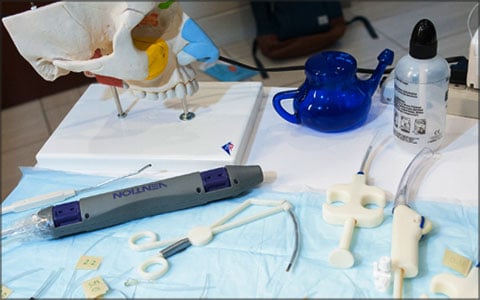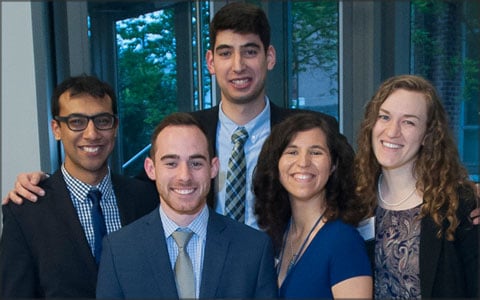A novel and innovative device to treat persistent and recurring sinus infections took the top award in the first-ever Johns Hopkins Student Healthcare Design Competition, held on the medical campus in early May and sponsored by the Johns Hopkins Center for Bioengineering Innovation and Design.
The competition, open to students from all Johns Hopkins divisions, was part of the Department of Biomedical Engineering’s Design Day. That annual event features presentations, posters, and prototypes of dozens of medical innovations developed over the year by student-clinician teams in BME’s Center for Bioengineering Innovation & Design.
Unlike the Johns Hopkins Business Plan Competition, which centers on business and market strategy, this challenge focused on the design and development of effective solutions to major health care problems. Forty-nine student teams from across the university submitted proposals, and 13 finalists competed in the May 3 event.
Attended by more than 300 researchers, clinicians, industry sponsors, and students, this year’s BME Design Day featured a keynote address by SynapDx CEO Stan Lapidus, a serial entrepreneur and inventor who founded and led Cytyc, Exact Sciences, and Helicos BioSciences, some inspired by the work of Johns Hopkins Medicine’s Bert Vogelstein, the Clayton Professor of Oncology and Pathology.
“Stan’s candid account of his experience was an inspiration,” says Youseph Yazdi, CBID’s executive director. “His innovations have saved millions of lives around the world, including here at Johns Hopkins. Today he gave a clear picture of the ups and downs, pivots, and perseverance necessary to be successful in health care innovation. I have no doubt there are several future Stans in that Design Day audience.”
The Healthcare Design Competition offered a $20,000 purse. First place, Salient ENT, received $4,000. Other top finishers included: Mercury Patch, a low-cost monitoring system for pressure sores (second place); and CricSpike, a hand-held device for emergency procedures on the battlefield to open a soldier’s blocked airway (third place).
“We’re thrilled to have received first place,” says Elizabeth Lebling, one of the inventors of Salient ENT, who graduates in May from the David E. Swirnow Master’s of Science in Bioengineering Innovation and Design program. “We’re starting conversations now with outside individuals who have experience translating these types of devices to the marketplace to help real patients.”
Roughly one in eight Americans suffer from persistent nasal sinus inflammation, Lebling says, and patients incur roughly $8.6 billion in annual surgical costs without adequate relief. Under the clinical direction of Andrew Lane, director of the Johns Hopkins Sinus Center, this design improves upon broad concepts developed by a 2012 CBID Team.


